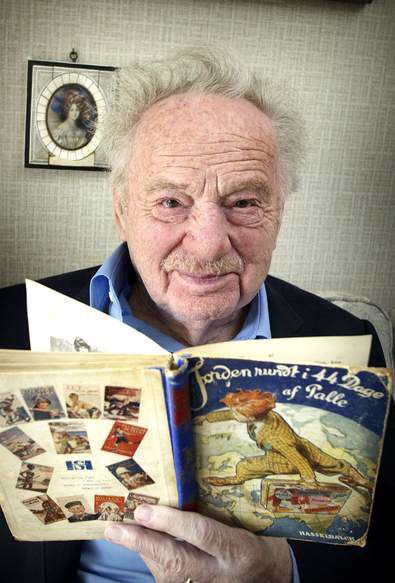Actor Palle Huld, 98, said to be real-life model of Tintin
Published 4:00 am Monday, December 6, 2010

- Danish film actor Palle Huld, who died Nov. 26, holds a copy of his book that chronicled his trip around the globe as a teenage boy. That journey reportedly inspired Belgian author Herge to create the cartoon character Tintin.
Palle Huld, a Danish actor whose fleet, youthful and highly public circumnavigation of the globe as a cowlicked teenager is believed to have inspired the popular comic-book character Tintin, died Nov. 26 in Copenhagen. He was 98.
His death was widely reported in Danish newspapers.
Created by the Belgian artist Herge (the pseudonym of Georges Remi), Tintin was a snub-nosed teenage reporter who traveled the world with his trusty dog, Snowy, doing good deeds and foiling bad men.
The character made his debut in January 1929 in Le Petit Vingtieme, the children’s supplement of a Belgian newspaper. Over the next half-century (Herge died in 1983), Tintin’s exploits were chronicled in two dozen illustrated books, starting with “Tintin in the Land of the Soviets” in 1930 and ending with “Tintin and Alph-Art,” published posthumously in 1986.
200 million copies
Translated into many languages, the books have sold more than 200 million copies worldwide, remain in print and retain an immense following.
A feature film, “The Adventures of Tintin: The Secret of the Unicorn,” produced by Steven Spielberg and Peter Jackson, is scheduled to open this month.
According to many accounts in the European news media over the years, Tintin exists, at least in part, because a young Danish clerk in search of adventure happened to answer a newspaper ad one day.
Huld’s life in the public eye began in 1928, when the Danish newspaper Politiken held a contest to honor the centennial of Jules Verne. The winner would re-enact Phileas Fogg’s voyage from “Around the World in Eighty Days,” Verne’s celebrated 1873 novel.
There were to be some crucial twists: The contest was open only to teenage boys; the winner would circle the globe unaccompanied; and he had to complete the trip within 46 days, using any conveyance but the airplane.
From several hundred applicants, the newspaper chose Palle, a 15-year-old Boy Scout who had left school and was working as a clerk in an automobile dealership.
Palle left Denmark on March 1, 1928, and as he traveled by rail and steamship the world press chronicled his every move, through England, Scotland, Canada, Japan, the Soviet Union, Poland and Germany.
It also chronicled his triumphant homecoming, after just 44 days, to a cheering crowd of 20,000 in Copenhagen. His safe return was “much to the relief of his mother, who had been prescribed sleeping tablets for the duration,” as The Copenhagen Post wrote in a profile of Huld this year.
The young Huld wrote a book about his adventures, which was published in several languages and appeared in English as “A Boy Scout Around the World” (Coward-McCann, 1929).
Tintin historians (and there are many) have posited various sources for Herge’s hero, including Palle Huld. Huld seemed to credit the connection, but Herge was not forthcoming on the subject, and Pierre Assouline, the author of “Herge: The Man Who Created Tintin,” published in English last year, said in an e-mail to The Times that he had never heard of Huld.
Similarities
Nevertheless, certain similarities between the intrepid Danish clerk and the intrepid Belgian scribe are indisputable: Like his comic-book incarnation, Palle Huld was fresh-faced and freckled, with a turned-up nose and unruly red hair. On his journey, Palle was often photographed wearing plus-fours, Tintin’s breeches of choice.
Palle Huld was born in 1912. He made his stage debut in 1934 at the Royal Danish Theater, with which he remained associated for many years. He also appeared regularly in Danish films and on television before his retirement a decade ago.
Information on survivors could not be confirmed. Huld is survived, at the very least, by his pen-and-paper incarnation, eternally inquisitive and eternally youthful.






